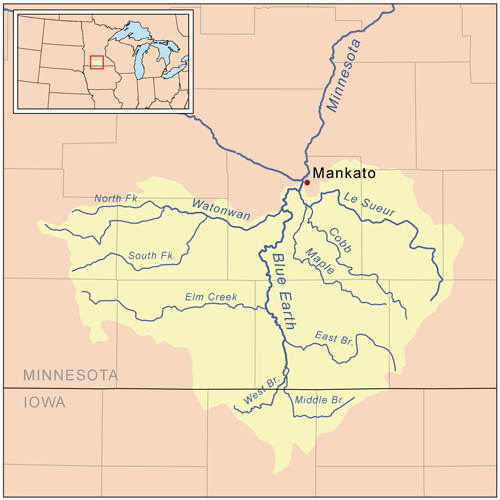What is this Blue Earth they speak of in southern Minnesota? There is a county of Blue Earth and a city of Blue Earth. However the city is not located in the county, rather it’s the seat of government in neighboring Faribault County. So the seat of Blue Earth County is Mankato which traces an etymological origin from a Dakota phrase(¹) for, um, blue earth(²).
Was there any doubt?
The River

They were all named for the Blue Earth River (Street View) which included much of the area discussed within its greater watershed. The city of Blue Earth formed at the confluence of the east and west branches of said river. That water flowed onward through the county of the same name. Then it went past Mankato at the confluence of the Blue Earth and Minnesota Rivers. These were all merely twigs on a much larger Mississippi River drainage basin.
Fair enough, however what actually inspired the notion of blue earth that named the river?
The Soil
I consulted several sources including Minnesota Place Names: A Geographical Encyclopedia, published by the Minnesota Historical Society. Genuine blue earth existed at one time, or more precisely,
“… a bluish green earth that was used by the Sisseton Dakota as a pigment, found in a shaley layer of the rock bluff of this stream about three miles from its mouth”
France was the first European nation to claim the area, not withstanding the opinions of the Native inhabitants. Numerous sources then described the efforts of French explorer, Pierre Charles Le Sueur in the 1690’s. He first noticed the so-called blue earth and thought the unusual discoloration might indicate the presence of copper. So he brought a sample back to France upon his return in 1695. A subsequent analysis did in fact detect copper.
Fort L’Huillier

Later, Le Sueur returned with a mining expedition in 1700. Then he built an encampment along the Blue Earth River which he named Fort L’Huillier. He supposedly returned to France with a substantial amount of the pigmented ore although the historical record gets fuzzy. Historians seem to agree that the bluish green earth lacked any copper whatsoever. Otherwise miners probably would have returned to the site. Opinions diverged on the question of whether Le Sueur thought he’d actually found copper or whether he’d purposely fabricated the evidence.
One theory suggested an intentional ruse. France had formed a trading alliance with the Fox tribe while simultaneously suspending trade with the rival Dakotas as part of the deal. The mining operation, so the explanation goes, would have provided a convincing cover story. Le Sueur could establish a physical presence close to the Dakota so he could trade with them quite lucratively without competition.
Le Sueur departed Fort L’Huillier with his “ore” after digging for a year. He left a contingent behind to maintain his encampment.
“… M D’Eraque and his little force of twelve men at Fort L’Huillier ran out of provisions and well nigh out of ammunition, and after waiting as long as possible, and having been attacked by the fierce Sioux and had three of their number killed in the woods, embarked all their merchandise in their boat, abandoned the fort and descended the rivers to the mouth of the Mississippi.”
Researchers believed the site of Fort L’Huillier topped a specific bluff overlooking the Blue Earth River (map). So someone eventually placed a marker near the supposed spot to commemorate its historical significance. However no actual archeological evidence exists. The search for Le Sueur’s fort continues.
Not a single trace of the blue earth that inspired the name remains anywhere within the watershed. Le Sueur an his crew removed every bit of it. Now this geological curiosity remains only in one’s imagination.
12MC Loves Footnotes!
(¹) From Minnesota Place Names: A Geographical Encyclopedia: “In the language of the Dakota the same word, to, is used both for blue and green, and their name of the Blue Earth River is Makato (maka, earth; to, blue or green). William H. Keating wrote in the Narrative of Stephen H. Long’s expedition, 1823: ‘By the Dacotas it is called Makato Osa Watapa, which signifies the river where the blue earth is gathered’. The Dakota name is retained, with slight change, by the township and city of Mankato.”
(²)This isn’t the first time 12MC has referred to the language of the Dakota Sioux for placenames in Minnesota. Remember “That’s Siouan for Water?”

Leave a Reply